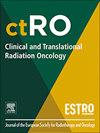Comparison of lifetime attributable risk of post-irradiation secondary cancer of boron neutron capture therapy, proton beam therapy, and X-ray therapy for pediatric and adolescent and young adult patients
IF 2.7
3区 医学
Q3 ONCOLOGY
引用次数: 0
Abstract
Background and purpose
This study aimed to compare the post-irradiation secondary cancer rates of boron neutron capture therapy (BNCT), proton beam therapy (PBT), and X-ray therapy (XT) in pediatric and Adolescent and Young Adult (AYA) patients with intracranial lesions.
Materials and methods
BNCT, PBT, and XT plans were optimized for nine pediatric and AYA patients with intracranial lesions. The BNCT dose calculation results were biologically effective dose converted. Lifetime attributable risk (LAR) was calculated using a calculation model proposed by Schneider et al. Statistical analysis was performed using log-linear model with mixed effects. Organs included in the radiation field were the brain, bones, and soft tissue. The difference in LAR between the three treatments for each organ and the number needed to treat (NNT), as an indicator of the number of cases required to achieve the effect of suppressing the occurrence of secondary cancers, was calculated and evaluated.
Results
Statistically significant differences between BNCT vs PBT and XT were confirmed for the brain, bone, soft tissue, and cumulative (P < 0.0001). Significant differences were also observed in PBT and XT, with P < 0.0001 for brain and cumulative, P = 0.0002 for bone, and P = 0.0281 for soft tissue. The cumulative NNT for BNCT vs. PBT, BNCT vs. XT, and PBT vs. XT were 162, 78.6, and 153, respectively.
Conclusion
BNCT had a significantly lower LAR compared to PBT and XT. These findings suggest the usefulness of BNCT in pediatric and AYA patients with brain tumors from the perspective of post-irradiation secondary cancer.
硼中子俘获治疗、质子束治疗和x射线治疗对儿童、青少年和青壮年患者辐照后继发癌的终生归因风险比较
背景与目的:本研究旨在比较硼中子俘获治疗(BNCT)、质子束治疗(PBT)和x线治疗(XT)在儿童和青少年及青壮年(AYA)颅内病变患者放疗后继发癌的发生率。材料和方法:对9例颅内病变的儿科和AYA患者进行BNCT、PBT和XT方案优化。BNCT剂量计算结果为生物有效剂量换算。终生归因风险(LAR)采用Schneider等人提出的计算模型进行计算。采用混合效应的对数线性模型进行统计分析。包括在辐射领域的器官是大脑、骨骼和软组织。计算和评估三种治疗方法对每个器官的LAR差异和所需治疗数(NNT),作为达到抑制继发性癌症发生效果所需病例数的指标。结果:BNCT与PBT、XT相比,在脑、骨、软组织和累积方面有统计学差异(P)。结论:BNCT的LAR明显低于PBT和XT。从放疗后继发性肿瘤的角度来看,这些发现提示BNCT在儿科和AYA脑肿瘤患者中的有用性。
本文章由计算机程序翻译,如有差异,请以英文原文为准。
求助全文
约1分钟内获得全文
求助全文
来源期刊

Clinical and Translational Radiation Oncology
Medicine-Radiology, Nuclear Medicine and Imaging
CiteScore
5.30
自引率
3.20%
发文量
114
审稿时长
40 days
 求助内容:
求助内容: 应助结果提醒方式:
应助结果提醒方式:


